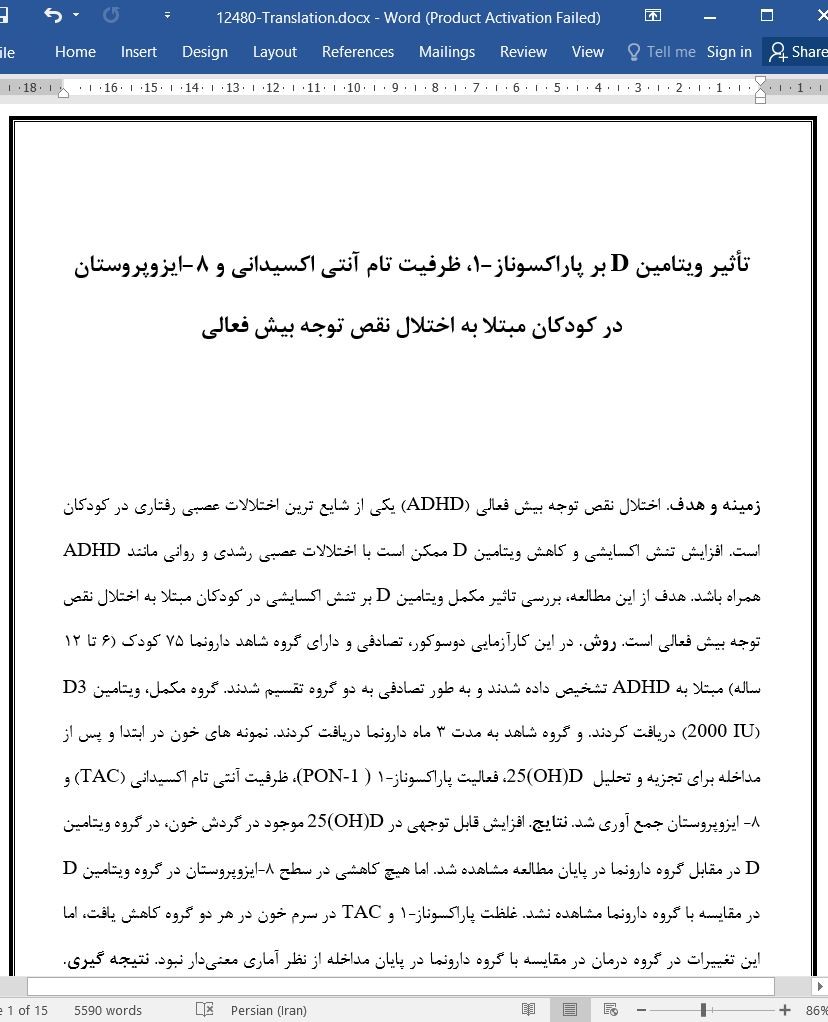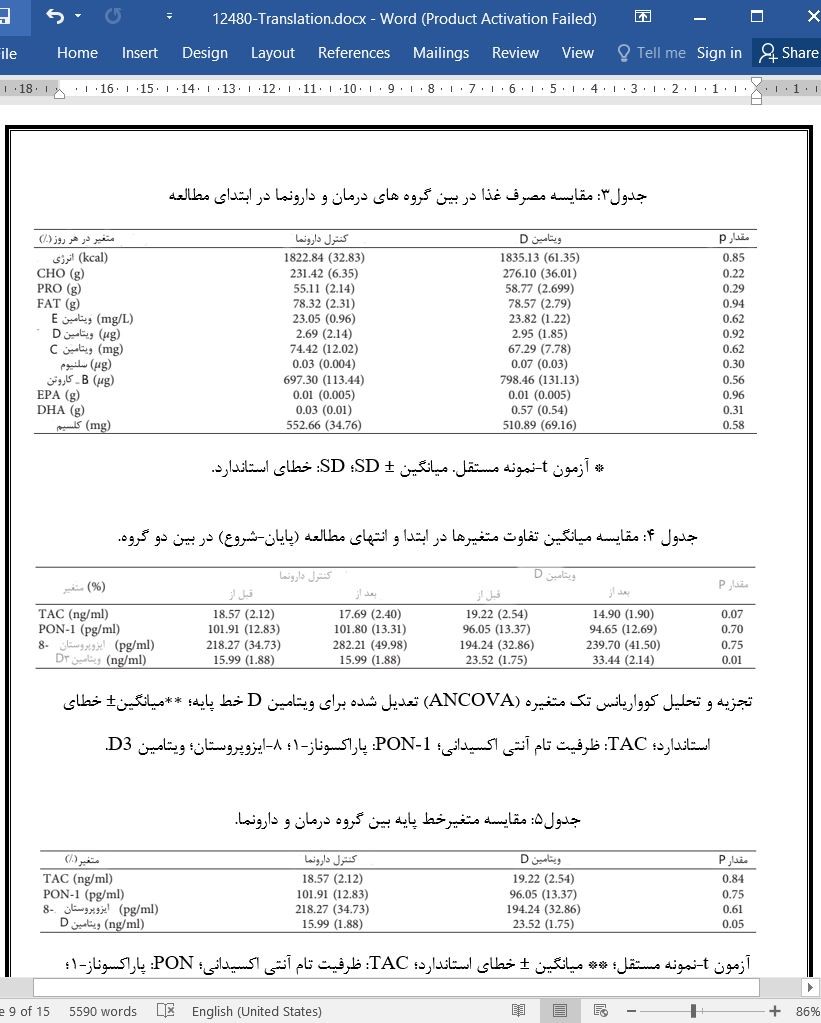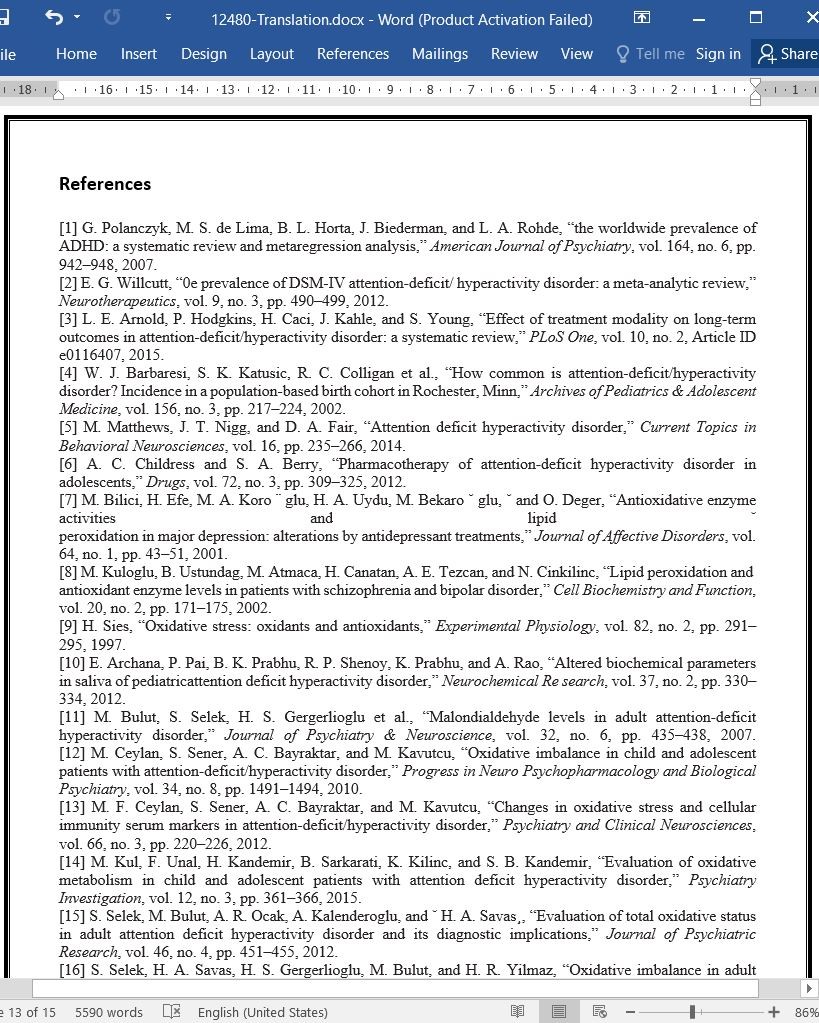
تأثیر ویتامین D بر پاراکسوناز-1، ظرفیت تام آنتی اکسیدانی و 8-ایزوپروستان در کودکان مبتلا به اختلال نقص توجه بیش فعالی
زمینه و هدف. اختلال نقص توجه بیش فعالی (ADHD) یکی از شایع ترین اختلالات عصبی رفتاری در کودکان است. افزایش تنش اکسایشی و کاهش ویتامین D ممکن است با اختلالات عصبی رشدی و روانی مانند ADHD همراه باشد. هدف از این مطالعه، بررسی تاثیر مکمل ویتامین D بر تنش اکسایشی در کودکان مبتلا به اختلال نقص توجه بیش فعالی است. روش. در این کارآزمایی دوسوکور، تصادفی و دارای گروه شاهد دارونما 75 کودک (6 تا 12 ساله) مبتلا به ADHD تشخیص داده شدند و به طور تصادفی به دو گروه تقسیم شدند. گروه مکمل، ویتامین D3 (2000 IU) دریافت کردند. و گروه شاهد به مدت 3 ماه دارونما دریافت کردند. نمونه های خون در ابتدا و پس از مداخله برای تجزیه و تحلیل 25(OH)D ، فعالیت پاراکسوناز-1 (PON-1 )، ظرفیت آنتی تام اکسیدانی (TAC) و 8- ایزوپروستان جمع آوری شد. نتایج. افزایش قابل توجهی در 25(OH)D موجود در گردش خون، در گروه ویتامین D در مقابل گروه دارونما در پایان مطالعه مشاهده شد. اما هیچ کاهشی در سطح 8-ایزوپروستان در گروه ویتامین D در مقایسه با گروه دارونما مشاهده نشد. غلظت پاراکسوناز-1 و TAC در سرم خون در هر دو گروه کاهش یافت، اما این تغییرات در گروه درمان در مقایسه با گروه دارونما در پایان مداخله از نظر آماری معنیدار نبود. نتیجه گیری. مصرف مکمل ویتامین D به مدت 3 ماه تاثیر چندانی بر نشانگرهای زیستی وضعیت تنش اکسایشی نداشت. برای تایید این یافته ها، توصیه می شود مطالعات بیشتری بر روی کودکان انجام شود.
1. مقدمه
اختلال نقص توجه بیش فعالی (ADHD) یکی از شایع ترین اختلالات عصبی در دوران کودکی است (1). شیوع ADHD در کودکان و نوجوانان حدود 6-7 % است و در پسران بیشتر از دختران دیده می شود (2). علائم اصلی ADHD عبارتند از ناتوانی در تمرکز و توجه، بیش فعالی، تکانشگری، و مشکلات در رفتار یادگیری و سازگاری روانی اجتماعی که ممکن است تا بزرگسالی هم ادامه پیدا کنند (3-5). علت دقیق ADHD مشخص نیست، اما فرضیه های مختلفی برای آن وجود دارد (6). یکی از این فرضیات این است که تنش اکسایشی در آسیب شناسیهای مختلف زمینه ساز بسیاری از اختلالات، مانند اختلال دوقطبی، اسکیزوفرنی، و افسردگی نقش دارد (7،8). تنش اکسایشی به عنوان یک مکانیسم مهم در تخریب، آسیب و مرگ سلول ها مورد تاکید قرار می گیرد. مطالعات اخیر نقش مهم تنش اکسایشی را در پاتوژنز بسیاری از اختلالات روانی نشان داده اند (9).
6. نتیجه گیری
در مجموع، نتایج این کارآزمایی بالینی در کودکان مبتلا به ADHD نشان می دهد که مصرف مکمل ویتامین D به مدت 3 ماه تاثیر چندانی بر روی نشانگرهای زیستی وضعیت تنش اکسایشی نداشته است. برای تایید این یافته، پیشنهاد می شود که مطالعات بیشتری بر روی کودکان انجام شود.
Background and Objective. Attention deficit hyperactivity disorder (ADHD) is one of the most common neurobehavioral disorders in children. Increased oxidative stress and decreased vitamin D may be associated with neurodevelopmental and psychiatric disorders, such as ADHD. The purpose of this study was to investigate the effect of vitamin D supplementation on oxidative stress in children with attention deficit hyperactivity disorder. Method. In this double-blind, randomized, placebo-controlled trial, 75 children (aged 6–12) diagnosed with ADHD were randomly assigned into two groups. The supplementation group received vitamin D3 (2000 IU), and the control group received a placebo for 3 months. Blood samples were collected at baseline and after intervention to analyze the 25(OH)D, paraxonase-1 activity (PON-1), Total Antioxidant Capacity (TAC), and 8-isoprostan levels. Results. A significant rise in circulating 25(OH)D was observed in the vitamin D group versus the placebo group at the end of the study. There was no reduction in 8-isoprostan levels in the vitamin D group compared to the placebo group. Serum paraxonase-1 and TAC concentration decreased in both groups, but these alterations were not statistically significant in the treatment group versus the placebo group at the end of the intervention. Conclusion. Vitamin D supplementation for 3 months did not have beneficial effects on biomarkers of oxidative stress status. To confirm these findings, further studies on children are suggested.
1. Introduction
Attention deficit hyperactivity disorder (ADHD) is one of the most prevalent neuropsychiatric disorders in childhood [1]. 0e prevalence of ADHD in children and adolescents is about 6-7%, and it is more frequent in boys than girls [2]. 0e main symptoms of ADHD are inability to concentrate and pay attention, hyperactivity, impulsivity, and difficulties in learning behavior and psychosocial adjustment, which may persist into adulthood [3–5]. 0e exact etiology of ADHD is unknown, but there are various hypotheses [6]. One of these is that oxidative stress is involved in various pathologies underlying many disorders, such as bipolar disorder, schizophrenia, and depression [7, 8]. Oxidative stress is emphasized as an important mechanism in the destruction, damage, and death of cells. Recent studies have suggested the important role of oxidative stress in the pathogenesis of many mental disorders [9].
6. Conclusions
Overall, the results of this clinical trial in children with ADHD show that vitamin D supplementation for 3 months International Journal of Clinical Practice 5 did not have beneficial effects on the biomarkers of oxidative stress status. To confirm this finding, further studies on children are suggested.
1. مقدمه
2. روش ها
2.1. طراحی و محیط آزمایش
2.2. شرکت کنندگان کارآزمایی
2.3. مداخله
2.4 ارزیابی متغیرها
2.5 تعیین اندازه نمونه
2.6 تصادفی سازی و تخصیص دارو
2.7 روشهای آزمایشگاهی
2.8 تحلیل آماری
3 نتایج
3.1 مشخصات پایه شرکت کنندگان در مطالعه
3.2 مصرف غذا
3.3 25(OH) D در گردش خون.
3.4 قرار گیری در معرض نور خورشید
3.5 نشانگرهای زیستی تنش اکسایشی
4 بحث
5 محدودیت ها
6 نتیجه گیری
منابع
1. Introduction
2. Methods
2.1. Trial Design and Setting
2.2. Trial Participants
2.3. Intervention
2.4. Assessment of Variables
2.5. Sample Size Determination
2.6. Randomization and Drug Allocation
2.7. Laboratory Methods
2.8. Statistical Analysis
3. Results
3.1. Baseline Characteristics of Study Participants
3.2. Dietary Intake
3.3. Circulating 25(OH)D
3.4. Sun Exposure
3.5. Oxidative Stress Biomarkers
4. Discussion
5. Limitation
6. Conclusions
References
- اصل مقاله انگلیسی با فرمت ورد (word) با قابلیت ویرایش
- ترجمه فارسی مقاله با فرمت ورد (word) با قابلیت ویرایش، بدون آرم سایت ای ترجمه
- ترجمه فارسی مقاله با فرمت pdf، بدون آرم سایت ای ترجمه



